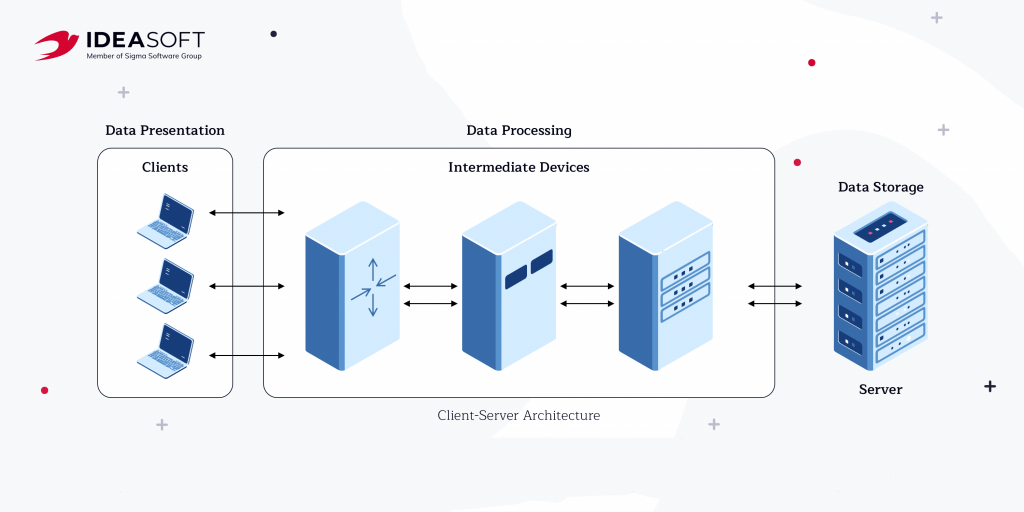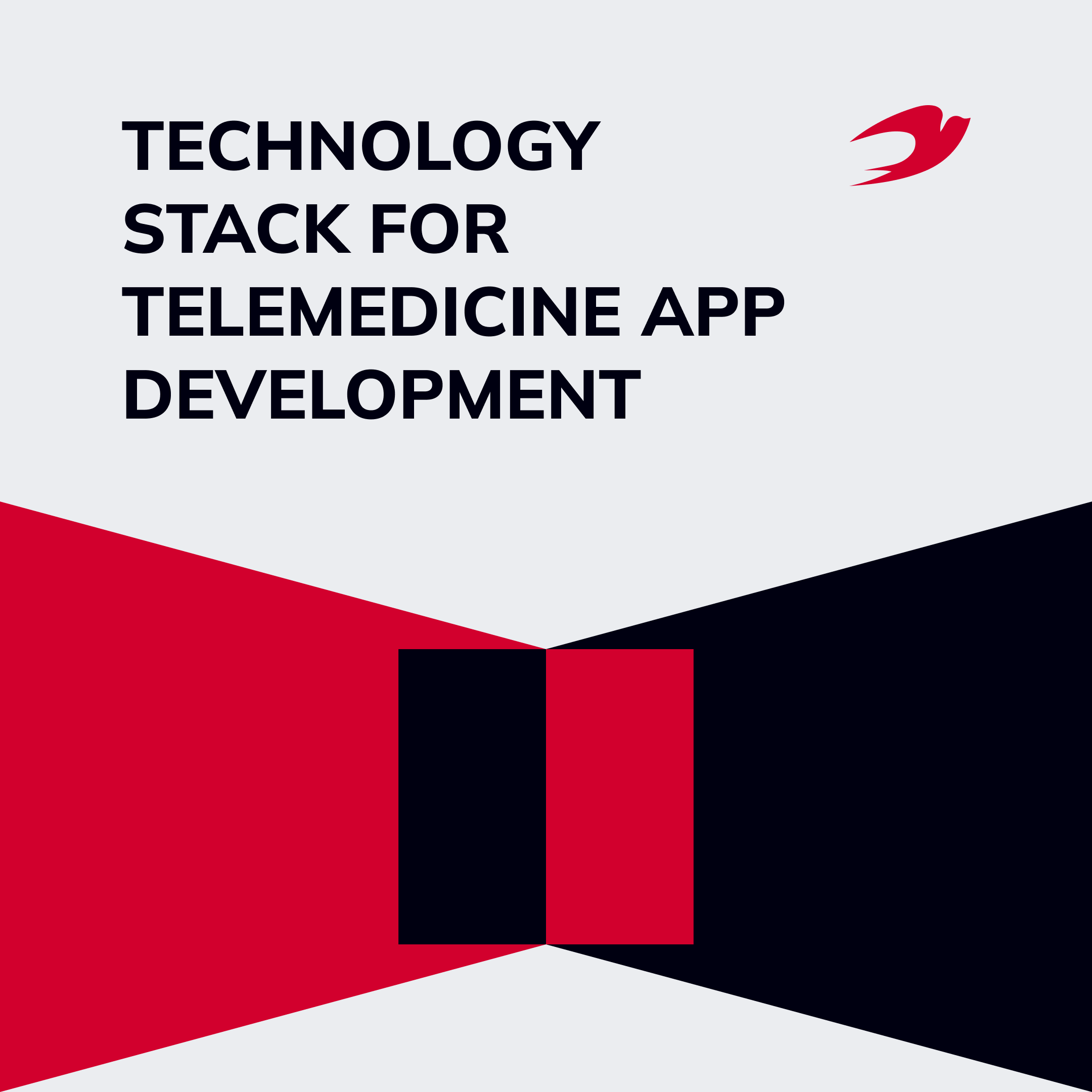Telemedicine applications store sensitive user data. They are also subject to high load, so such apps need to be secure and productive. To ensure this, developers need to use technologies capable of providing a good balance between security and performance. In this article we’ll talk about how to choose the right technology stack for telemedicine app development and what factors impact this.
Table of contents:
- Programming languages used in telemedicine
1.1 iOS app development
1.2 Android app development
1.3 Cross-platform app development - Third-party integrations
- Innovative technology for telemedicine app development
- Final thoughts
Programming languages used in telemedicine
The technology stack dramatically affects any IT project. Depending on the technology chosen, the time, quality, and cost of development can change. Moreover, it affects scalability, so if an IT project was developed on a poorly selected tech stack, it can cause some problems in the future. That’s why it’s okay if it takes you longer than planned to choose a technology stack for telemedicine app development.
A technology stack is a set of programming languages, frameworks, and software needed to develop an application. It consists of programming languages, frameworks, libraries, APIs, SDKs, etc. Before starting telemedicine app development, you will also need to decide on the structure of the application.
Since applications usually consist of client and server parts, the requirements for their functionality change the programming languages, frameworks, and software with which they can be developed. In other words, the requirements for client and server functionality affect the selection of technologies for development.

The duration of telemedicine app development depends on the complexity of the technical part, the features of the user interface, and its functionality. The price of developing a telemedicine application depends on the complexity of the project and the number of program functions. Choosing features for creating a telemedicine app is generally not the easiest task, especially if you want to offer maximum services to doctors and patients.
So, what are the best programming languages to use for healthcare apps? Let`s talk about them in detail
iOS app development
Swift is the number one technology for iOS telemedicine app development. This programming language allows you to build rich applications backed by robust and secure code. Apple created Swift back in 2014 as a simpler and more reliable programming language for iOS applications. Not surprisingly, it quickly pushed its main competitor Objective-C, out of the market.
The main advantages of Swift include the following:
- Simplicity. Apple likes minimalism. That’s why Swift has a simple syntax. It is easy to read, and easy to write in. Swift is easily understood by developers who know other languages. This fact is crucial when developing an application for multiple platforms.
- Security. Another strong point of Swift is its functional security. This statically typed language allows programmers to quickly find errors before compiling and fixing them. Security is a crucial factor for any telemedicine app, and Swift is a great technology to provide a high level of information security.
- Swift has automatic memory management. It manages the application memory by itself. Now developers don’t have to waste time doing so. As a result, it helps reduce the time required to create an application.
- It’s open-source. Swift went open-source in 2015. This event greatly influenced the popularity of the language. In 2015 it became the favorite language of Github users, and in 2016 it ranked second. Thanks to open source, Swift is rapidly evolving and improving.
- It’s functionally interoperable. Thanks to its integration with Objective-C (Objective-C Runtime Library), it is possible to write programs in Swift, C, Objective-C, and C++ simultaneously.

Android app development
Java and Kotlin are used for Android app development. Kotlin was created as an analog of Java, and many developers believe that Kotlin is superior to its master. So, Kotlin has the following advantages:
- Improved performance. Kotlin’s creators achieved improved performance through an intuitive syntax. It takes fewer lines to write a program and therefore not as much time. Thus, the result is achieved much faster.
- Full compatibility with Java. This means that you can call Kotlin functions from Java and Java methods from Kotlin. Great news for both programmers and large companies working with large databases in Java.
- Easy support. Kotlin is built into the most popular IDEs (like Android studio and some other SDKs). Therefore, Android developers don’t have any difficulty supporting the code. Especially since the toolkit remains familiar.
- Reliability. Working in different versions can be a big headache for programmers. But not in the case of Kotlin, since the latest version of this language is backward compatible with each of the previous ones.
- Official Android Studio support. Kotlin is supported by Android Studio, and thanks to the adaptation tools, programmers can use both Java and Kotlin at the same time.
Despite the growing popularity of Kotlin, Java is still a powerful, versatile platform for creating Android applications. Java has solid libraries, developments, and ready-made solutions in its arsenal. It is undoubtedly the leader in security, reliability, and agility.
Read also How Blockchain Transforms Healthcare
Java has the following advantages:
- Simplicity. It has clear syntax rules and clear semantics. Rationality and brevity are very useful for processing code by machines with limited resources.
- Security. Developers have done a lot of work to protect the Java platform. It is extremely difficult to bypass or hack the security mechanisms.
- Reliability. Programs in Java are stable in all conditions. The compiler can detect bugs at the earliest stages before the code is even executed. Runtime control prevents memory failures (such as those caused by an inaccurate pointer).
- Independence from the hardware and the operating system. It is only important to have an executable environment and JVM. The computer architecture doesn’t matter. Bytecode can be easily interpreted on any machine.
- Convenient and efficient networking features. Applications can easily find the necessary objects in the network and access them. There’s an extensive software library for transferring data via the most widespread protocols: FTP, HTTP, TCP/IP.
Convenient and efficient networking features. Applications can easily find the necessary objects in the network and access them. There’s an extensive software library for transferring data via the most widespread protocols: FTP, HTTP, TCP/IP.
Cross-platform app development
React Native, Xamarin, and Flutter are used for cross-platform app development. The choice of one of these programming languages depends on the healthcare software development priorities.
React Native is quite versatile. Developers can use the same code to implement an application for different operating systems. Also, it’s easy to update. Any changes made to the JavaScript part of the code on React Native allow programmers to update the app without having to download a new version from the App Store or Google Play. React Native provides good UX and easy UI changes that open up many opportunities for developers and users.
Xamarin is an open-source platform for creating effective Android, iOS, and Windows cross-platform apps based on .NET technology. It allows for the creation of a single code base for all platforms and it provides direct access to the native API of each platform. {amarin supports multiple platforms. The main ones are Android, iOS, UWP, Tizen. Additional platforms are being developed by the community for MacOS, WPF, GTK.
Flutter is Google’s free open-source framework for cross-platform application development. It is written in the Dart language. Flutter significantly speeds up the application development process. It has an expressive and flexible interface. With Flutter it is possible to quickly submit features based on end-user experience. A multi-tiered architecture provides full customization for incredibly fast rendering and expressive designs. Also, this technology provides fast performance. The Hot Reload feature helps programmers experiment quickly and easily, create custom interfaces, add features, and fix bugs faster.

Third-party integrations
A key requirement for quality telemedicine and telehealth software systems is their seamless integration with existing systems and tools. For example, these could be EHR, Video calls and Video Conferencing, payment getaway, etc. Additionally, your healthcare app might need documentation of telemedicine visits, synchronization of insurance programs, integration with patient portals, medical APIs, revenue cycle management platforms, etc.
All of the above are critical to providing patients with convenient care. Some telemedicine apps are built directly to “communicate” with mobile medical devices. You should keep in mind that the possibility of quality third-party integration depends on the chosen technology stack for telemedicine app development. All technologies used must provide compatibility in order to ensure a high level of security and not bring unnecessary vulnerabilities to the system. To do this, developers need to conduct a detailed analysis and select a tech stack that meets your business requirements and security standards.
Innovative technology for telemedicine app development
Digital technology has changed the delivery of health care in many ways. The reorientation toward patient-centered care creates favorable conditions for the further development of healthcare technologies and positive growth dynamics for this market segment. Telemedicine is seen as the future of healthcare and it continues to evolve. Among innovative technologies used in telemedicine app development are machine learning, artificial intelligence, chatbots/voice assistants, and IoT. Let’s talk about them in detail.
Machine Learning. ML and automation help optimize hospital processes, map diseases and treat infectious diseases as well as personalize treatment. Machine learning can also be used to create “smart” electronic medical records for imaging and diagnostics, remote patient monitoring, and much more.
Artificial Intelligence. Artificial intelligence and deep learning can be used to identify and classify images to help improve diagnostic accuracy in disease detection and promote better patient outcomes. AI technology also helps automate the telemedicine process, from scheduling to consultations, exams, diagnosis, and billing.
Chatbots/Voice Assistants. Chatbots and virtual medical assistants can perform many functions, from customer service to diagnostic tools or virtual therapy. Speech recognition technology continues to improve, and user interest in voice search is growing. It is possible to create virtual assistants to meet all patient needs for quality and seamless communication with the provider.
IoT combined with telemedicine is creating a new trend, the Internet of Medical Things (IoMT). It involves the use of a variety of medical wearable devices that collect specific health data either by patients actively submitting data or using sensors to provide real-time care. Its effectiveness depends on the reliability of healthcare software development.
Final thoughts
Developing a telemedicine app is almost a must-have investment for clinics of any size and a good idea for a startup. Medical mobile apps have been downloaded hundreds of times more frequently over the last 5 years, and especially since 2020. People don’t want to stand in a queue and put their health at risk. It’s a practical solution for doctors to provide better medical care and waste less time.
Also, don’t forget that healthcare software development requires an experienced development team able to select the best technology stack for telemedicine app development and bring your ideas to life with it. Over the last 5 years the IdeaSoft team has delivered innovative software solutions for various business domains, including the healthcare industry. Working with startups and enterprises, we have accumulated unique expertise that allows us to meet the needs of different types of business. Feel free to learn more about IdeaSoft services and contact us.

